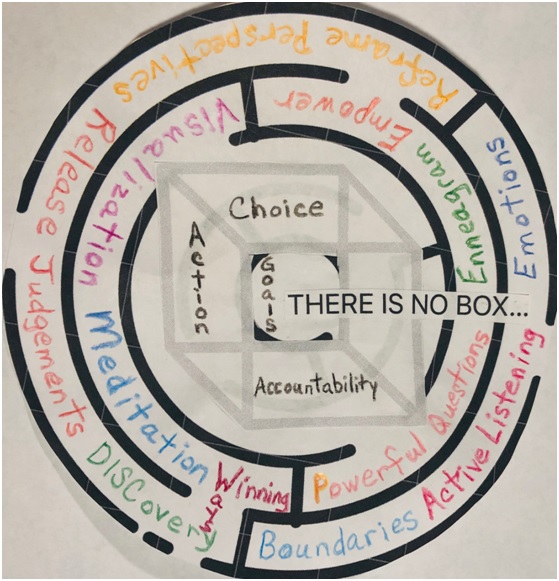A Coaching Model Created by Amy Lechelt
(Transformation Coach, UNITED STATES)

Thinking outside the box simply means that you’re willing to consider different solutions and methods for reaching your desired outcome. That is to say: You want to get from point A to point B, but you don’t necessarily need or want to take the tried and true route to get there. entreprenuer.com Timothy Sykes, VIP contributor
Smile at your critics for they have yet to see the universe that exists outside the box- Paul Bradley Smith
In general, I believe that there is “no box”. Nor argument for right vs. wrong when choosing what we wish to create for ourselves. We have a plethora of choices and options from which to choose. I feel my background and life experiences most relate to the Steppa, Success, and Transformational coaching models which lend themselves to creating with an awareness of possible self-limiting beliefs.
If you want something you’ve never had, you must be willing to do something you’ve never done. – Thomas Jefferson
In coaching a client to realize their desired action/s and goal/s, I feel this may be explored through connecting to their authentic self. For example, through meditation-type exercises, awareness of underlying feelings or beliefs, active listening, and powerful questioning.
I believe the following tools, which incorporate many of the ICA core competencies, will provide a valuable baseline for my coaching practice.
- Active Listening, Powerful Questioning
- DISCovery, Enneagram, Winning Ways
- Emotions
- Meditation, Visualization
- Reframe Perspective, Release Judgements
- Empower, Boundaries
Everything you’ve ever wanted is on the other side of fear.- George Addair
-
Active listening, Powerful Questioning:
A client’s desire to feel heard is monumental. As a coach listens for possible reoccurring words, change in pitch, their body language, and possible underlying fears, for example, we are being truly present in the coaching session. The acronym WAIT- why am I talking? (ICA Power listening module), is a wonderful reminder while coaching. Does it involve genuine curiosity, without judgment, regarding the client’s learning and the session-agreement? Acknowledgment, for instance, of a Breakdown=Breakthrough?! Thought-provoking questions through active listening can propel our client forward through the exploration of their underlying beliefs, possible self-sabotage, and their authentic desired outcome.
-
DISC, Enneagram, Winning Ways:
I think, if desired by the client, providing suggestions such as these for further awareness may be helpful (additionally Strength Finder and/or Meier’s Brigg); as well for the coach’s further insight. For instance, a client may be interested in exploring and learning how their Enneagram shadow may help create further personal development. As well, provide awareness in acknowledging their strengths, talents, and interests.
-
Emotions:
Establishing trust and intimacy with the client is of the utmost importance. We provide a safe environment for the client to explore their feelings, values, beliefs, and desires. Creating awareness for our client to label their underlying feelings is valuable for their learning and growth. By providing information for a listing of emotions, for example, found on emotions.org, it may be of value for the client. Building on emotional intelligence can be a powerful aid in breaking-free of emotional stillness or stagnation.
-
Meditation, Visualization:
I have found these tools to be helpful not only in tapping into one’s intuition and self-awareness, but also to return to a calmer state-of-mind, breathe, and being present. Visualization can be a helpful tool that allows a client to open up to their hidden desires and unspoken goals without judgment. Visualizing a hopeful outcome through the shift of perspective, gut feelings, intuition, and elimination of self-limited beliefs. To allow being in the unknown through meditation and see what may come to you. Ultimately, to verbalize and describe what it looks like…it is limitless when you create through visualization!
-
Reframe perspective, Release judgment:
These tools can provide an exploration, learning, of an alternate perspective than one’s own. An understanding found through compassion or empathy, thus the release of possible judgment. Is it possible that one’s perceived thoughts or ideas are not the truth, rather belief or judgment? Does this keep a client stuck? Bad vs Good, Right vs Wrong…. Possibly, in gently challenging a client’s thinking from a state of negativity to positivity, it may create action toward the client’s authentic desired outcome. Discomfort can be the underlying feeling before creating change. In many cases, what is true is what we choose to believe.
-
Empower, Boundaries:
The feeling of confidence for a client (or coach), may empower in creating action for themselves and/or the world around them. Creating awareness and learning for a client regarding their values, beliefs, or boundaries, for example, may bring them to owning their freedom to choose. Distinguishing these and one’s values brings one to their authentic-self and passion in taking action! Empowering the client to access new thinking through their journey.
It isn’t enough to think outside the box. Thinking is passive. Get used to acting outside the box.-Tim Ferriss
The Labyrinth:
A labyrinth is an ancient symbol that relates to wholeness. It combines the imagery of the circle and the spiral into a meandering but purposeful path. The Labyrinth represents a journey to our own center and back again out into the world. www.lessons4living.com
I have walked many labyrinths as a form of meditation or calming the mind. I see a labyrinth as an analogy for our journey through life. The thoughts, stories, beliefs, awareness’…we learn as we walk through life. In a labyrinth, although there is a center end-point, to exit one must continue to walk the labyrinth once again. One must go through to get to the other side. Explore, learn, awareness, process, choice, action, and begin again…
Unlike a maze, which has dead ends and the possibility of getting lost, a labyrinth has a clear path, but it sometimes takes unexpected twists and turns. Eastern Mennonite University www.emu.edu
Amy, walking the labyrinth of life…